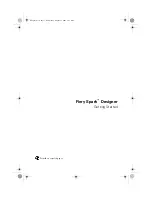
Radiosity Processing
11
188
Lightscape
for the light sources you want to ray trace. This
process produces the best visual result. For more
information, see Chapter 14, “Rendering.”
The benefit of ray tracing these light sources is that
the underlying mesh during the radiosity solution
can be relatively coarse, as long as there is enough
light to ensure some inter-reflections. That is, you
have to see some light on the wall from the radiosity
calculations. The illustration on the left shows the
original radiosity solution from which the ray-
traced image on the right was generated.
Ray tracing light sources, however, can add a signif-
icant amount of time to the rendering process, so
you only want to ray trace those lights that appear in
a final image. Fortunately, you can set the ray tracing
option even after the radiosity solution is complete.
In this way, you can first evaluate the solution from a
particular view before deciding which shadows or
light sources you need to refine in the final image.
For more information, see Chapter 8, “Artificial
Lighting.”
Prevent with Softened Edges
For spotlights, it is easier to get a good radiosity
result with a sparse mesh if the edges are soft—a
floodlight, for example. The following examples
were generated from the same mesh parameters and
have the same intensity values. However, the light in
the top example has a beam angle of 30
°
and a field
angle of 30
°
(a sharp spotlight).
The light in the bottom example has a beam angle of
30
°
and a field angle of 90
°
.
If you use a photometric web distribution, or if you
want a sharp spotlight, you must resort to a finer
mesh or to the ray tracing process described previ-
ously to correct jagged shadow boundaries.
Shadow Leaks
As the name implies, a shadow leak appears as a dark
region that seems to start from under an object or
wall and “leaks” out to the surrounding surface.
For example, consider the panel against the wall in
the following image. The mesh generated for this
radiosity solution (on the right) shows that one of
the initial mesh vertices on the wall surface occurred
behind the panel. Although there was some adaptive
Left: Solution produces jagged shadow boundaries
on the wall
Right: Ray tracing image corrects jagged shadow
boundaries
Top: Sharp spotlight produces jagged shadow boundaries
Bottom: A softer spotlight prevents the occurrence of
jagged shadow boundaries
Summary of Contents for LIGHTSCAPE
Page 1: ...SULO 4 31 93 36034333308355 LJKWVFDSH...
Page 18: ...NOTES 10...
Page 110: ...NOTES 102...
Page 136: ...NOTES 128...
Page 166: ...NOTES 158...
Page 176: ...NOTES 168...
Page 202: ...NOTES 194...
Page 210: ...NOTES 202...
Page 248: ...NOTES 240...
Page 294: ...NOTES 286...
Page 308: ...NOTES 300...
Page 316: ...NOTES 308...
Page 324: ...NOTES 316...
Page 342: ...Glossary 334 Lightscape...
Page 360: ...Index ix 352 Lightscape...
Page 362: ......
















































